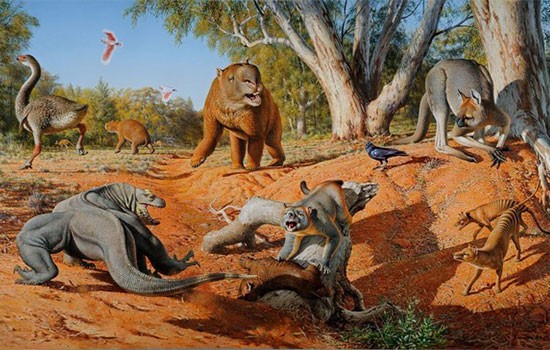By Ana Verayo, | January 21, 2017

A new study involving the University of Monash and CU Boulder indicates humans are to blame for the extinction of the Australia megafauna. ( Peter Trusler / Monash University)
A new study has provided compelling evidence showing that Australia's megafauna went extinct 45,000 years ago due to human hunting and not because of climate change. Scientists have determined that large animals were able to adapt to Earth's drying climate but unfortunately were wiped out within a few thousand years after the first group of people arrived in the continent.
Like Us on Facebook
A team from the University of Colorado in Boulder revealed that these animals became lost forever due to an "imperceptible overkill" or occasional killing due to hunting offspring or young animals, preventing animal populations from recovering and ultimately pushing them into extinction.
Scientists examined evidence from ocean sediments revealing chronological layers of material that sunk into the sea including dust, pollen, ash and spores from a special fungus that thrived on animal feces during that time.
The team was able to identify the overall climate of the planet during that time (some 45,000 years ago) based on the animal feces. This abundance of these spores proves that large mammals thrived on the southwestern regions of Australia, according to Gifford Miller of Colorado University.
However, a sudden decline of large animals occurred within 2,000 years of human occupation on the land. Australia's landscape became drier some 70,000 years ago when lush eucalyptus forests transformed into low lying shrubs. However, this did not have a significant effect on fungus spores development.
The team suggests that this low intensity hunting of killing one juvenile per person for every decade can result in a species population disappearing in a few hundred years. This selective, low level hunting is now virtually imperceptible in archaeological records due to lack of record kill sites.
Among the megafauna that was lost during this period is a flightless bird at two meters tall called the Genyornis newtoni. Also lost are the Sthenurus kangaroo, which weighed up to 240 kilograms, and the Diprotodon optatum wombat that weighed almost two tons and had strong claws and feet.
According to the lead author of the study, Sander van der Kaars from Monash University in Australia, the results of this study has provided new insight into how megafauna or giant animals that once roamed the planet disappeared due to human colonization of Earth.
This new study was published in the journal Nature Communications.
-
Use of Coronavirus Pandemic Drones Raises Privacy Concerns: Drones Spread Fear, Local Officials Say

-
Coronavirus Hampers The Delivery Of Lockheed Martin F-35 Stealth Fighters For 2020

-
Instagram Speeds Up Plans to Add Account Memorialization Feature Due to COVID-19 Deaths

-
NASA: Perseverance Plans to Bring 'Mars Rock' to Earth in 2031

-
600 Dead And 3,000 In The Hospital as Iranians Believed Drinking High-Concentrations of Alcohol Can Cure The Coronavirus

-
600 Dead And 3,000 In The Hospital as Iranians Believed Drinking High-Concentrations of Alcohol Can Cure The Coronavirus

-
COVID-19: Doctors, Nurses Use Virtual Reality to Learn New Skills in Treating Coronavirus Patients







